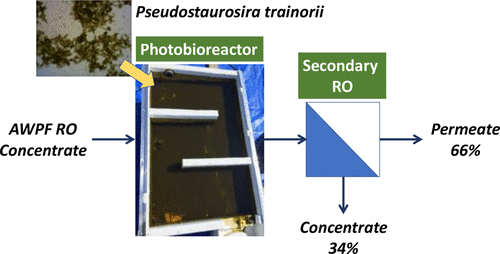当前位置:
X-MOL 学术
›
Environ. Sci. Technol.
›
论文详情
Our official English website, www.x-mol.net, welcomes your
feedback! (Note: you will need to create a separate account there.)
Water Recovery from Advanced Water Purification Facility Reverse Osmosis Concentrate by Photobiological Treatment Followed by Secondary Reverse Osmosis
Environmental Science & Technology ( IF 10.8 ) Pub Date : 2018-07-09 , DOI: 10.1021/acs.est.8b00951 Keisuke Ikehata 1 , Yuanyuan Zhao 1 , Harshad V. Kulkarni 1 , Yuan Li 1 , Shane A. Snyder 2 , Kenneth P. Ishida 3 , Michael A. Anderson 4
Environmental Science & Technology ( IF 10.8 ) Pub Date : 2018-07-09 , DOI: 10.1021/acs.est.8b00951 Keisuke Ikehata 1 , Yuanyuan Zhao 1 , Harshad V. Kulkarni 1 , Yuan Li 1 , Shane A. Snyder 2 , Kenneth P. Ishida 3 , Michael A. Anderson 4
Affiliation

|
Reverse osmosis (RO)-based desalination and advanced water purification facilities have inherent challenges associated with concentrate management and disposal. Although enhanced permeate recovery and concentrate minimization are desired, membrane scaling due to inorganic constituents, such as silica, calcium, phosphate, and iron, hinders the process. To solve this problem, a new diatom-based photobiological process has been developed to remove these scaling constituents by biological uptake and precipitation. In this study, RO concentrate samples were collected from a full-scale advanced water reclamation facility in California and were treated in 3.8 and 57 L photobioreactors inoculated with a brackish water diatom Pseudostaurosira trainorii PEWL001 using light-emitting diode bulbs or natural sunlight as a light source. The photobiological treatment removed 95% of reactive silica and 64% of calcium and enabled additional water recovery using a secondary RO at a recovery rate up to 66%. This represents 95% overall recovery, including 85% recovery in the primary RO unit. In addition to the scaling constituents, the photobiological treatment removed 12 pharmaceuticals and personal care products, as well as N-nitrosodimethylamine, from RO concentrate samples primarily via photolysis. This novel approach has a strong potential for application to brackish water desalination and advanced water purification in arid and semiarid areas.
中文翻译:

通过光生物处理从高级净水设施反渗透浓缩液中回收水,然后进行二次反渗透
基于反渗透(RO)的海水淡化和先进的净水设施具有与精矿管理和处置相关的固有挑战。尽管期望提高渗透物的回收率并最大程度地减少浓缩物,但是由于无机成分(例如二氧化硅,钙,磷酸盐和铁)而导致的膜结垢阻碍了该过程。为了解决这个问题,已经开发了一种新的基于硅藻的光生物学方法,以通过生物摄取和沉淀去除这些结垢成分。在这项研究中,从加利福尼亚的大型先进水回收设施中收集了RO精矿样品,并在3.8和57 L光生化反应器中进行了处理,这些光生物反应器接种了微咸水硅藻 Pseudostaurosira trainoriiPEWL001使用发光二极管灯泡或自然阳光作为光源。光生物处理去除了95%的反应性二氧化硅和64%的钙,并使用次要RO以高达66%的回收率实现了额外的水回收。这代表了95%的整体回收率,其中包括主要RO装置中的85%的回收率。除结垢成分外,光生物学处理主要通过光解从RO精矿样品中除去了12种药品和个人护理产品以及N-亚硝基二甲胺。这种新颖的方法在干旱和半干旱地区的微咸水淡化和高级水净化方面具有强大的应用潜力。
更新日期:2018-07-10
中文翻译:

通过光生物处理从高级净水设施反渗透浓缩液中回收水,然后进行二次反渗透
基于反渗透(RO)的海水淡化和先进的净水设施具有与精矿管理和处置相关的固有挑战。尽管期望提高渗透物的回收率并最大程度地减少浓缩物,但是由于无机成分(例如二氧化硅,钙,磷酸盐和铁)而导致的膜结垢阻碍了该过程。为了解决这个问题,已经开发了一种新的基于硅藻的光生物学方法,以通过生物摄取和沉淀去除这些结垢成分。在这项研究中,从加利福尼亚的大型先进水回收设施中收集了RO精矿样品,并在3.8和57 L光生化反应器中进行了处理,这些光生物反应器接种了微咸水硅藻 Pseudostaurosira trainoriiPEWL001使用发光二极管灯泡或自然阳光作为光源。光生物处理去除了95%的反应性二氧化硅和64%的钙,并使用次要RO以高达66%的回收率实现了额外的水回收。这代表了95%的整体回收率,其中包括主要RO装置中的85%的回收率。除结垢成分外,光生物学处理主要通过光解从RO精矿样品中除去了12种药品和个人护理产品以及N-亚硝基二甲胺。这种新颖的方法在干旱和半干旱地区的微咸水淡化和高级水净化方面具有强大的应用潜力。











































 京公网安备 11010802027423号
京公网安备 11010802027423号